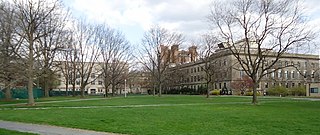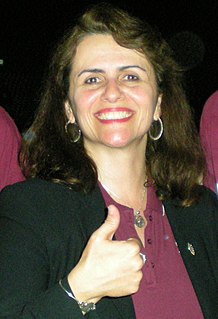
Norman Ernest Borlaug was an American agronomist who led initiatives worldwide that contributed to the extensive increases in agricultural production termed the Green Revolution. Borlaug was awarded multiple honors for his work, including the Nobel Peace Prize, the Presidential Medal of Freedom and the Congressional Gold Medal.

The New York State College of Agriculture and Life Sciences at Cornell University is a statutory college and one of the four New York State contract colleges on the Cornell University campus in Ithaca, New York. With enrollment of approximately 3,100 undergraduate and 1,000 graduate students, CALS is the third-largest college of its kind in the United States and the second-largest undergraduate college on the Cornell campus.

Mankombu Sambasivan Swaminathan is an Indian agronomist, agricultural scientist, plant geneticist, administrator and humanitarian. Swaminathan is a global leader of the green revolution. He has been called the main architect of the green revolution in India for his leadership and role in introducing and further developing high-yielding varieties of wheat and rice. Swaminathan's collaborative scientific efforts with Norman Borlaug, spearheading a mass movement with farmers and other scientists and backed by public policies, saved India and Pakistan from certain famine-like conditions in the 1960s. His leadership as Director General of the International Rice Research Institute (IRRI) in the Philippines was instrumental in his being awarded the first World Food Prize in 1987, recognized as the Nobel or the highest honours in the field of agriculture. United Nations Environment Programme has called him 'the Father of Economic Ecology'.
The College of Engineering is the engineering school of Texas A&M University in College Station and is home to more than 15,000 engineering students in 14 departments.

The Texas A&M College of Science is the science college of Texas A&M University in College Station. The faculty includes a Nobel laureate and three National Academy of Sciences members. In 2006, the faculty collected a combined $38.5 million in peer-reviewed federal funding, and annually generates over $5 million in indirect cost return for Texas A&M.

The Courant Institute of Mathematical Sciences is the mathematics research school of New York University (NYU), and is among the most prestigious mathematics schools and mathematical sciences research centers in the world. Founded in 1935, it is named after Richard Courant, one of the founders of the Courant Institute and also a mathematics professor at New York University from 1936 to 1972, and serves as a center for research and advanced training in computer science and mathematics. It is located on Gould Plaza next to the Stern School of Business and the economics department of the College of Arts and Science.
The Rausser College of Natural Resources (CNR), a college of the University of California, Berkeley, is the oldest college in the University of California system (UC) and home to several internationally top-ranked programs. CNR's Department of Agriculture & Economics is considered to be one of the most prestigious schools in agricultural economics in the world, ranking #1 according to the Journal of Agricultural and Applied Economics, #1 by the Chronicle of Higher Education, #1 by Perry for its Ph.D. programs and in International Trade, #1 by the National Research Council in Agricultural & Resource Economics, and #1 by U.S. News in Environmental/Environmental Health. In environmental disciplines, QS World Rankings recognizes the University of California, Berkeley, as the world's leading university in Environmental Studies with 100 points in Academic Reputation. U.S. News also ranks it as the best global university for environment and ecology. A study of AJAE authors and their university affiliations found it to have the highest number of pages per research faculty member.
Subrahmaniam Nagarajan is an Indian wheat pathologist. He studied in Chennai till high school and completed his early education at the Agriculture College, Coimbatore, then pursued his masters at the Indian Agriculture Research Institute, New Delhi and received his doctorate in Agriculture from the Delhi University. He is the Project Director of the All India Wheat program and author of more than 120 research papers, 50 book chapters and two textbooks.

The College of Natural Sciences at The University of Texas at Austin offers 10 Bachelor of Arts majors, 42 Bachelor of Science majors, and 20 graduate programs to more than 11,000 undergraduates and 1,400 graduate students. The college employs over 370 faculty. Many of the programs are consistently ranked in the top ten nationally, according to U.S. News & World Report (2019), including: Analytical Chemistry (4th), Applied Math (9th), Artificial Intelligence (8th), Computer Science (10th), Computing Systems (8th), Computing Theory (7th), Cosmology/Relativity/Gravity (10th), Ecology, Evolution and Behavior (6th), Mathematics Analysis (7th), Plasma Physics (3rd), Programming Language (8th), and Topology (8th). It was established in 1883.
Ronald L. Phillips is an American biologist and a Regents Professor at the University of Minnesota. In 1985 he was elected a fellow and the American Association for the Advancement of Science and in 1991 he was elected to the National Academy of Sciences.

Elsa Alina Murano is the former President of Texas A&M University.

Chittagong Veterinary and Animal Sciences University (CVASU) is a public university in Bangladesh. It is the only specialised veterinary university in Bangladesh. It is located at Khulshi, Chattogram. The chancellor of the university is president Abdul Hamid. Generally, the public universities in Bangladesh offer degree on department. Like every other agricultural university in Bangladesh, CVASU offers degree on faculty.

The College of Engineering (CoE) is one of the three undergraduate colleges at the University of California, Santa Barbara.
The College of Agriculture and Life Sciences is one of eight colleges at Virginia Tech with a three-part mission of learning, discovery, and engagement and it is one of the best agriculture programs in the nation. It has more than 3,100 undergraduate and graduate students in a dozen academic departments. In 2013, the National Science Foundation ranked Virginia Tech No. 6 in the country for agricultural research expenditures, much of which originated from the College of Agriculture and Life Sciences.
Gurdev Singh Khush is an Agronomist and Geneticist who, along with mentor Henry Beachell, received the 1996 World Food Prize for his achievements in enlarging and improving the global supply of rice during a time of exponential population growth.
The Borlaug Global Rust Initiative was founded in response to recommendations of a committee of international experts who met to consider a response to the threat the global food supply posed by the Ug99 strain of wheat rust. The BGRI was renamed the Borlaug Global Rust initiative in honor of Green Revolution pioneer and Nobel Peace Prize Laureate Dr. Norman Borlaug who worked to establish and lead the Global Rust Initiative.
George Frederick Sprague was an American geneticist and maize researcher. He was a faculty member at the Iowa State University and the University of Illinois and a researcher at the U.S. Department of Agriculture. He is credited with developing a genetically strong line of maize known as Iowa Stiff Stalk Synthetic. A recipient of the Wolf Prize in Agriculture, Sprague was also a fellow of the American Association for the Advancement of Science and a member of the National Academy of Sciences.
Robert James Cook is an American phytopathologist. He is best known for his work on soil-borne pathogens affecting wheat. He is the recipient of a Guggenheim Fellowship and the Wolf Prize in Agriculture and is a member of the National Academy of Sciences.
Ronnie Coffman is an American plant scientist and professor. He is director of numerous research projects dedicated to international agriculture, food security and gender equity in agriculture. He received the World Agriculture Prize in 2013. He was named a 2019 Fellow of the American Association for the Advancement of Science.







